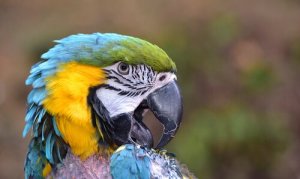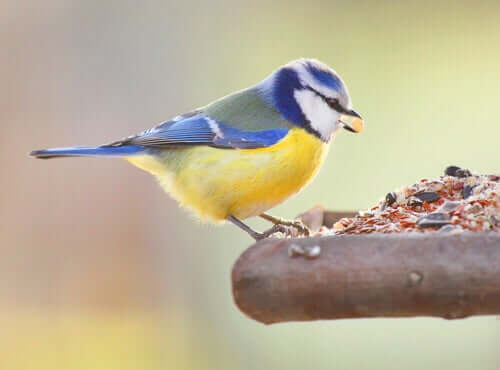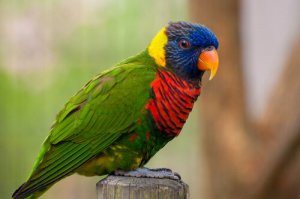Feathers Can Reveal Diseases in Birds


Written and verified by the lawyer Francisco María García
Either due to their softness, striking colors, or the function they fulfill, bird feathers have always been an object of much curiosity for many people. What you might not be aware of is that feathers can also reveal diseases in their bearers.
To begin with, let’s see what role they play in birds’ bodies.
What are feathers?
Feathers are an element that differentiates most birds from other animals and they’re configured by a structure that protrudes from the skin. Reptilian scales are its predecessors. At least, this is the hypothesis after observing their similarities in growth and keratin composition.
Birds’ feathers can reveal diseases, among other functions

Feathers originally emerged to help with body temperature control and this function hasn’t changed. However, they also have other functions, and these are some of the most important:
- Camouflage is an important function of bird feathers as it allows them to adapt to their environment. For instance, they don’t only disguise them from their predators but also help them attract potential prey.
- Feathers are also courtship elements for the mating rituals of some types of birds
- Certain birds wet their breast’s feathers to bring water to their nests
- They muffle the bird’s movement sounds so that they can hunt silently – we’re talking mainly about nocturnal hunters
- Even though feathers lack nerves, they do stimulate the nerve points of the surrounding skin
- Certain birds, such as ducks, float using through the air between their feathers
- Protection against inclement weather. Keratin is an important substance in feathers and is water-resistant. It can also protect against the wear and tear caused by the wind or the sun. Feathers also act as insulation against cold temperatures after a bird gets wet.
- Due to their firmness and rigidity, feathers allow birds to fly.
Can feathers truly reveal diseases?

A patient, systematic observation will reveal changes in a bird’s plumage. These changes might be due to a genetic, pathological, or stress disorder.
Thus, changes in the color, firmness, and brightness of the feathers are signs that show that something is wrong with the animal. This also applies to their eyes and beak.
There are several other aspects you can detect in a bird by observing changes in its plumage. These are some of the best-known:
Pseudo-molt
Normally a bird sheds its plumage about two or three times a year. But, molting periods are unpredictable when the temperature is higher than usual. Move the bird to a cooler place if you notice this.
Pecking
This is a form of self-harm the bird inflicts upon itself, and it’s due either to parasites or stress. As you can imagine, it’s very unpleasant for them. So, consult your veterinarian about doing an external deworming procedure.
Chrysanthemum disease
This is a congenital disorder in which the growth of the feathers stops abruptly.
Feathers can reveal diseases like follicular cysts
There’s no cure for this condition but surgery is an optional treatment. A follicular cyst originates when the feathers grow into the skin instead of growing out of it.
Polyomavirus
You can recognize this disease by the emergence of small red dots on the wings. It’s common in parakeets and usually leads to a lack of hunger and depression. It’s usually fatal in young birds.
Pododermatitis
This is an aggressive disease that disintegrates a bird’s skin. This highly dangerous condition is due to bacteria. An infected bird will die from it if not detected in time.
In conclusion, feathers can definitely reveal diseases, you just to be aware and on the lookout.
General recommendations
You must keep in mind that birds are highly sensitive animals who often get stressed and this can lead to health problems.
A poor diet can also lead to disorders that affect feather growth in a bird.
Also, you must constantly monitor your bird’s appearance, for the reasons we’ve mentioned in this article. However, keep in mind that you must seek professional help if any of the aforementioned problems occur. A veterinarian can detect diseases and anomalies more accurately and prescribe the most appropriate treatment.
Either due to their softness, striking colors, or the function they fulfill, bird feathers have always been an object of much curiosity for many people. What you might not be aware of is that feathers can also reveal diseases in their bearers.
To begin with, let’s see what role they play in birds’ bodies.
What are feathers?
Feathers are an element that differentiates most birds from other animals and they’re configured by a structure that protrudes from the skin. Reptilian scales are its predecessors. At least, this is the hypothesis after observing their similarities in growth and keratin composition.
Birds’ feathers can reveal diseases, among other functions

Feathers originally emerged to help with body temperature control and this function hasn’t changed. However, they also have other functions, and these are some of the most important:
- Camouflage is an important function of bird feathers as it allows them to adapt to their environment. For instance, they don’t only disguise them from their predators but also help them attract potential prey.
- Feathers are also courtship elements for the mating rituals of some types of birds
- Certain birds wet their breast’s feathers to bring water to their nests
- They muffle the bird’s movement sounds so that they can hunt silently – we’re talking mainly about nocturnal hunters
- Even though feathers lack nerves, they do stimulate the nerve points of the surrounding skin
- Certain birds, such as ducks, float using through the air between their feathers
- Protection against inclement weather. Keratin is an important substance in feathers and is water-resistant. It can also protect against the wear and tear caused by the wind or the sun. Feathers also act as insulation against cold temperatures after a bird gets wet.
- Due to their firmness and rigidity, feathers allow birds to fly.
Can feathers truly reveal diseases?

A patient, systematic observation will reveal changes in a bird’s plumage. These changes might be due to a genetic, pathological, or stress disorder.
Thus, changes in the color, firmness, and brightness of the feathers are signs that show that something is wrong with the animal. This also applies to their eyes and beak.
There are several other aspects you can detect in a bird by observing changes in its plumage. These are some of the best-known:
Pseudo-molt
Normally a bird sheds its plumage about two or three times a year. But, molting periods are unpredictable when the temperature is higher than usual. Move the bird to a cooler place if you notice this.
Pecking
This is a form of self-harm the bird inflicts upon itself, and it’s due either to parasites or stress. As you can imagine, it’s very unpleasant for them. So, consult your veterinarian about doing an external deworming procedure.
Chrysanthemum disease
This is a congenital disorder in which the growth of the feathers stops abruptly.
Feathers can reveal diseases like follicular cysts
There’s no cure for this condition but surgery is an optional treatment. A follicular cyst originates when the feathers grow into the skin instead of growing out of it.
Polyomavirus
You can recognize this disease by the emergence of small red dots on the wings. It’s common in parakeets and usually leads to a lack of hunger and depression. It’s usually fatal in young birds.
Pododermatitis
This is an aggressive disease that disintegrates a bird’s skin. This highly dangerous condition is due to bacteria. An infected bird will die from it if not detected in time.
In conclusion, feathers can definitely reveal diseases, you just to be aware and on the lookout.
General recommendations
You must keep in mind that birds are highly sensitive animals who often get stressed and this can lead to health problems.
A poor diet can also lead to disorders that affect feather growth in a bird.
Also, you must constantly monitor your bird’s appearance, for the reasons we’ve mentioned in this article. However, keep in mind that you must seek professional help if any of the aforementioned problems occur. A veterinarian can detect diseases and anomalies more accurately and prescribe the most appropriate treatment.
This text is provided for informational purposes only and does not replace consultation with a professional. If in doubt, consult your specialist.








